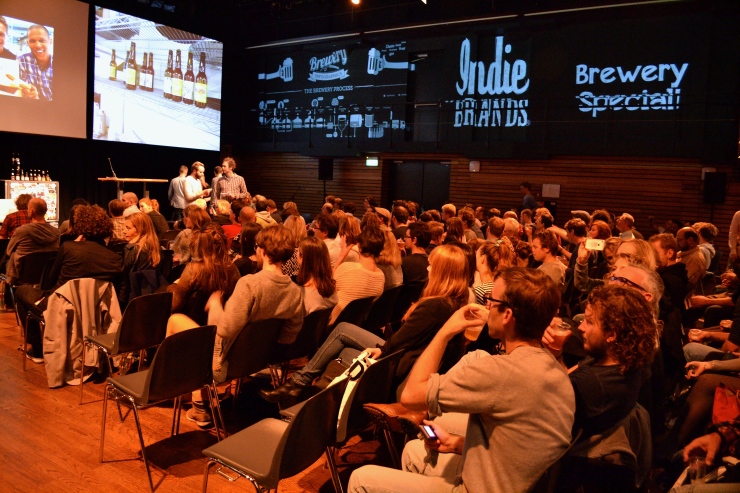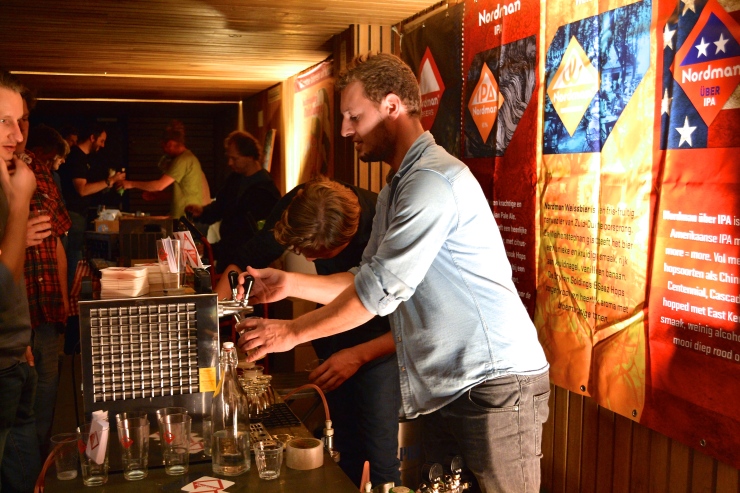 Pakhuis de Zwijger*, Amsterdam played host to a spirited night of brewers, beers and brands at the 7th edition of the Indie BRANDS Event. Showcasing 16 of the best microbreweries in the Netherlands, the Indie Brands Brewery Special featured an inspiring evening of fascinating talks and exquisite beer tastings. With more than 243 independent breweries emerging over the last 10 years, craft beer making is rapidly becoming a Dutch phenomenon. While the market remains relatively small (roughly 5%) compared to other countries (15% in the US), microbrewers in the Netherlands are optimistic that there is ample room for growth.
Pakhuis de Zwijger*, Amsterdam played host to a spirited night of brewers, beers and brands at the 7th edition of the Indie BRANDS Event. Showcasing 16 of the best microbreweries in the Netherlands, the Indie Brands Brewery Special featured an inspiring evening of fascinating talks and exquisite beer tastings. With more than 243 independent breweries emerging over the last 10 years, craft beer making is rapidly becoming a Dutch phenomenon. While the market remains relatively small (roughly 5%) compared to other countries (15% in the US), microbrewers in the Netherlands are optimistic that there is ample room for growth.
Newcomers Amsterdam Brewboys kicked-off the event by sharing their insights on their initiation into the micro brewing world. Like most indie beer brewers in the Netherlands, founders Pieter Langedijk and Sebastiaan van den Bosch began their journey with a love for craft beer and their disappointment in the lack of brands and styles that were available. “It happened really by accident,” Langedijk says. “You start with an idea and you start doing it. You buy some pots and pans; that’s how you brew beer.” As simple as this may seem, the pair face serious challenges in bringing their product to market. “We need to plan ahead because we are contract brewers and we need get space [to brew] at the [big] breweries,” Van den Bosch claims. “We plan to have our own brewery, optimistically, by the end of next year.”
 A place to brew your own
A place to brew your own
At the same time, Brouwerij de Vriendschap’s Peter Harms and Aart van Bergen are also looking to start their own brewery BrouwLab at the new Stadslandbouwproject NoordOogst in Amsterdam. The two friends began experimenting with different brews at home –using CD stickers as homemade bottle labels– before officially launching their brand in 2013. In order to increase production capacity, they also began contract brewing at a brewery in Raalte in the east of the Netherlands. “The nice thing about that place is that you can brew [the beer] yourself,” Van Bergen says. “We like to learn about how the beer is brewed and to learn how to use the professional equipment.” With this knowledge, the duo is embarking on a new project, converting an old football dugout-cum-locker room into their very own beer laboratory where they plan to experiment on new recipes before going into production.
Meanwhile, Brouwerij de Prael is taking a different approach to their brewing. Since 2001, the brewery has been employing people with psychological issues as part of a mental healthcare program in cooperation with the Dutch Association of Mental Health and Addiction Care (GGZ Nederland). “We are a social enterprise (sociale werkplaats) with a commercial undertaking,” says Sales and Marketing Manager Hilde Amian. “What people with psychological issues do [in other mental healthcare programs] is really boring. How cool is it that you can make beer?” With over 120 volunteers, the brewery has grown into a legitimate business in the heart of Amsterdam, which, incidentally, poses its own set of problems. Unlike most microbreweries that are located outside city centers, Brouwerij de Paerl tackles logistical, waste management and public disturbance issues on a daily basis. Nevertheless, the brewery has become an intrinsic part of the local community.

American influence
While most Dutch craft brewers are making headway at home, Indie Brands veteran Rick Nelson and the rest of Oedipus Brewing are looking to other lands for inspiration. In particular, the four-man troupe headed to Portland, Oregon or, as Portland natives like to call it, Brewvana. Invited to exhibit their best brews at this year’s Oregon Brewers Festival, the Oedipus boys made what they felt was a journey of a lifetime. So much so, they decided to make a documentary about their experience. “Portland is such a great place to learn not only about beer, but also about food and sustainability,” Nelson claims. “This place has all the [natural] resources to make beer. I got really inspired by this way of working, close to the producers. In the Netherlands we need to make this happen. We don’t need to become Portland or the West Coast, but we need to look to the future.”
Indeed, the Dutch craft beer industry has gotten off to a late start compared to other countries like the US. According to Nelson, this has a lot to do with European brewers wanting to preserve their traditions. As a result, Dutch consumers tend to prefer pilsners (which, depending on who you talk to, is not considered to be “real” beer) or German and Belgian-style brews. “The good thing is, Amsterdam is really growing as a beer city,” Nelson says. “More brewers are popping up. In the end, you will have a choice of what to drink and know what you want to drink.”
 Keeping up the pace
Keeping up the pace
The evening’s talks were brought to a close by Brouwerij ‘t IJ’s Patrick Hendrikse, co-owner of the oldest (founded in 1985) and largest microbrewery in the Netherlands. In 2008, Hendrikse and his partner Bart Obertop bought the brewery from the original founder Kaspar Peterson. Since then, the pair has initiated a revival of the iconic beer brand and has expanded ‘t IJ’s production capacity by opening a second brewery in Amsterdam-Oost. Even with the extra facilities, the brewery is still trying to keep up with demand. “We doubled our capacity because we were getting sick of managing a [supply] deficit,” Hendrikse says. “The bad thing about making everything you can is that you can’t experiment as much. We are really busy with getting the beer out there.”
Despite the supply challenges, Hendrikse is pleasantly surprised by the growing enthusiasm for craft beer in the Netherlands. “We all come from a pilsner-drinking country,” Hendrikse explains. “Once you’ve tasted and found a beer you really like, you experiment more, but you don’t fall back to [pils].” As a matter of fact, the independent, craft beer movement has made a significant impact on multinational brewing companies, which try to emulate the look and feel of microbrews in their marketing campaigns. “I just think they picked something up [from us], but they’re missing a point,” Hendrikse claims. “Why don’t they just make really great beer and don’t do marketing and sell it? People don’t realize that. We all make fun of them and they make fun of us, but that’s with all the brewers. They don’t see us as competition because we make so little.”

With the rising success of microbreweries in the Netherlands, it appears that craft beer is here to stay and can only get better over time. As with all indie brands, these brewers dare to be different, investing all their time, effort and savings into something that they are truly passionate about. By bringing their specially made brews into the market, these brands are providing more choices for consumers and are educating them in the process on what beer can be. Undeterred by the many risks and challenges of starting a business on their own, these microbrewers are thriving in ever-growing market, putting the Netherlands firmly on the map of quality craft beer. ✌

☞ For more information on Indie Brands, the Indie Brands Events and other brands featured in the Indie Brands blog, visit the websites listed below:
☞ All event photographs featured in this post and in the Indie Brands Blog are courtesy of Phillip Q. Gangan ©phillipqgangan2014
